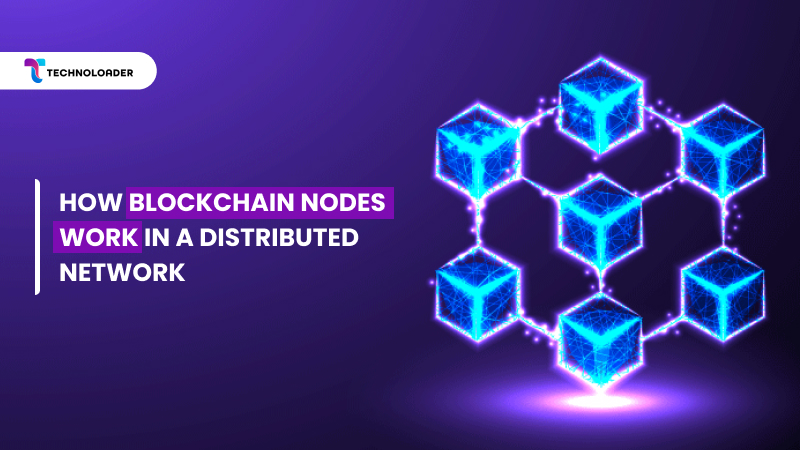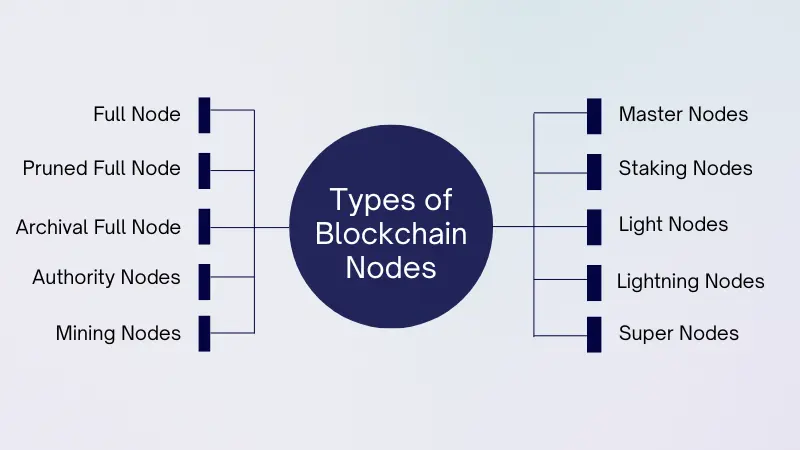Since you’re a blockchain user, have you ever wondered who keeps the blockchain running? How does blockchain remain secure even without a central server in charge?
Well, your answer lies in nodes!
Nodes keep the blockchain alive, secure, and decentralised, all while recording transactions and sharing information with one another, without the need for a central authority. Whether sending cryptocurrency, minting NFTs, or using a DeFi dApp, nodes continue to work behind the scenes, ensuring that everything runs smoothly and transparently.
So, without wasting your precious time, let’s break down how blockchain nodes work!
What Are Blockchain Nodes?
If we talk about what blockchain nodes are, these are generally computers connected to a blockchain network that store, share, and verify all the data significantly.
Just think of them as the “guardians” of the blockchain, who typically keep a copy of the ledger, check whether every transaction is correct, and ensure that everyone agrees on the same version of the truth.
Let’s simplify it with an example:
- Imagine you send 1 Bitcoin to your friend.
- Before your friend receives it, nodes check whether you have 1 Bitcoin to spend and haven’t already sent it to someone else.
- Thus, once nodes agree, your transaction is added to a new block and becomes part of the blockchain.
So, without nodes, no one would validate transactions or keep the blockchain running. They’re what make a blockchain decentralized, secure, and trustworthy.
Anatomy of a Blockchain Node
The anatomy of a blockchain node simply means knowing the leading parts that make up a node and how they work together to keep the blockchain running smoothly. Meanwhile, a node is not just a thing; it comprises software, storage, networking, and rules that allow it to participate in the blockchain network.
However, here is what a blockchain node consists of:
Blockchain Client Software:
Usually, every blockchain node begins with the blockchain client software, which is generally the program that allows the computer to function as a node. This software is responsible for downloading the blockchain, applying all the consensus rules, and maintaining constant communication with the rest of the network. Thus, a computer can’t participate in the blockchain network without the client software.
Businesses often rely on professional blockchain development companies to set up secure nodes and client software correctly.
Local Blockchain Database:
Another crucial part of a node is its local blockchain database, which is often known as ledger storage. This database holds a copy of the blockchain, either the entire history of full nodes or just block headers for light nodes. However, having this local copy enables the node to easily verify all the significant transactions, check the balance, and stay updated with the network. The memory of the node keeps track of everything that has functioned on the blockchain.
Networking Layer:
The networking layer allows the node to talk to other nodes in a peer-to-peer network. This layer plays a crucial role because it enables nodes to share new transactions and blocks with one another. It further ensures that every participant can see the same blockchain version. Continuous communication keeps the network decentralized and synchronized across the globe.
Consensus & Validation Logic:
Inside the node, the consensus and validation logic acts as its brain. This component typically verifies every incoming transaction and block that follows the network’s rules. For example, it prevents someone from spending the same coins twice or submitting invalid data. Doing so ensures that only the right information is added to the blockchain, prioritizing trust and security.
API / RPC Interface:
Several nodes often include an API or RPC interface, which acts as a bridge between the node and applications like wallets, dApps, or block explorers. This interface allows software to interact with the blockchain, send transactions, and fetch information such as account balance or transaction history.
Types of Blockchain Nodes
Blockchain nodes are grouped by the functions they perform. Despite their differences, all of them work towards the betterment of a network. However, the different types of blockchain nodes include
Full Node
The nodes are the servers of a decentralized network, often keeping a blockchain’s transaction history, syncing, storing, copying, and distributing data while also evaluating new blocks. They continuously supervise rule adherence, building reliable data that stays honest.
Pruned Full Node
The main role of this node is to set a memory limit. Here, pruning typically begins upon installation, where all the nodes download a blockchain in its entirety and begin deleting all but the metadata from their oldest blocks, retaining only the most current entries, until capacity is achieved.
Archival Full Node
This node generally gathers the entire blockchain ledger, recording all the transactions up to its genesis block. Comparatively, these are the most common types of nodes and can be categorized into four groups, including authority, miner nodes, staking nodes, and master nodes.
Authority Nodes
These nodes are commonly chosen by a community to act as administrators of a private or slightly centralized blockchain.
Mining Nodes
Found in proof-of-work platforms like Bitcoin, these nodes carry out the mathematically intensive task of creating new blocks and submitting them to the blockchain.
Master Nodes
These full node types verify transactions and maintain records. They frequently do not generate new blocks.
Staking Nodes
These nodes use a method known as “staking” in their authentication process. By using this method, the funds are locked as a guarantee, and a proof-of-stake consensus model randomly designates authentication by powering participants who have met predetermined metrics, such as contributing a certain amount of tokens to the protocol or logging in a certain number of hours on a network.
Light Nodes
Second to archival nodes in usage popularity, these nodes are designed for fast, simple processing of transactions and daily activities. They’re equipped with only the essential data and depend on full nodes to function, as they do not download the full blockchain.
Lightning Nodes
To balance network congestion, lightning nodes execute transactions off-chain through individual, out-of-network connections. Once the process is done, the transactions themselves are added to the primary blockchain. This round of work typically makes low-cost, instantaneous exchanges while lightning maintains the load on the network.
Super Nodes
Among all, these are the rarest node variations, where supernodes are generally developed on demand to perform specialized tasks such as enforcing protocol changes or sustaining protocols.
Node Functions in a Blockchain
In the blockchain, nodes play a very crucial role in forming new blocks of transactions. They frequently accept or reject a block based on its legitimacy, and once a node accepts a new transaction block, it archives and stores it on top of the prior blocks. However, the primary function of blockchain nodes includes
Maintaining the Ledger:
The primary function of a node is to preserve the ledger; they typically store and keep a copy of the entire and distributed ledger, which includes all the transaction records. By holding copies of the ledger, nodes make sure that the network can continue to function and data remains secure even if nodes go offline. Meanwhile, they generally act as the “source of truth.”
Validating Transaction:
In blockchain, nodes inspect new batches of transactions, also known as blocks, to guarantee their authenticity before they’re added to the blockchain network. This process typically consists of checking digital signatures, ensuring adequate funds for the transaction, and confirming compatibility with the blockchain’s protocol rules.
Communicating and Broadcasting:
Nodes act as communication centers within the network, forwarding data such as new transactions and freshly validated blocks to other nodes. This process of sharing often spreads information across the network, updating the ledger and making sure all parties have an up-to-date and uniform view of the blockchain. This sharing of information maintains the network’s integrity and controls fraudulent activities like double-spending.
Consensus Mechanisms and Node Roles
Consensus mechanisms are the way blockchain nodes agree on which transactions are valid and which block should be added next. Instead of having a single central server in charge, they work together with thousands of nodes and maintain the blockchain accuracy and security.
In proof-of-work blockchains like Bitcoin, superior nodes called miners solve mysteries to add new blocks. Meanwhile, in proof of stake, blockchains like Ethereum select validators based on how much cryptocurrency they’ve locked up, which saves energy compared to PoW.
Each type of node plays a role: full nodes check every transaction, validator or miner nodes build new blocks, and light nodes rely on full nodes for verification. Combined, they hold the network fair, secure, and decentralized.
Process of Running a Blockchain Node
Running a blockchain node may sound technical, but it’s a straightforward process. Let’s discover how it works:
Step 1: Select the Blockchain Network:
First, decide which blockchain you want to support: Bitcoin, Ethereum, or any other network. Each blockchain has its own specialty, so determine your preference and pick the right one.
Step 2: Download the Node Software:
After selecting the ideal blockchain network, visit the official portal for the blockchain and download the correct client software. For example, Bitcoin users can download Bitcoin Core, Ethereum users can download Geth or Nethermind, and so forth. Ensure you get the software from the official source to avoid security risks.
Step 3: Install and Configure the Software:
Install the node software on your computer or server. During setup, you may be asked whether you’re likely to run a full node or a light node, so here you must be aware that full nodes share security and independence but require more disk space.
Step 4: Sync with the Blockchain:
Once you’re done with the installation, your node will start downloading and verifying the entire blockchain history. This process is called synchronization, and it often can take hours or even days, based on the size of the blockchain and your internet speed.
Step 5: Connect to the Network:
Once your node is synced, it connects with other nodes in a peer-to-peer network. This allows it to receive new transactions, validate them, and share them with others in real time.
Step 6: Keep It Running:
For your node to be most helpful, it should stay online as much as possible. A node that runs 24/7 contributes to network reliability by sharing data continuously.
This is how nodes run; however, if you’re likely to use your node with wallets or dApps, then you can also choose to enable the RPC interface. This allows your applications to fetch blockchain data directly from your node rather than relying on third-party services.
Further, running a node is a great initiative to learn about blockchain technology, enjoy better privacy, and support the network’s decentralization.
Challenges of Running Nodes
So, you’ve understood how blockchain nodes run; here are some common challenges you must also be aware of before executing nodes in a distributed network:
- High Storage Requirements: Full nodes require hundreds of GBs of disk space, and the size keeps growing.
- Constant Internet Usage: Nodes must stay connected to send, receive, and validate data in real time.
- System Uptime: Your computer is required to stay online most of the time to stay in touch with the network.
- Technical Setup: Setting up, syncing, and sustaining the node can be challenging for beginners.
Conclusion
To conclude, blockchain nodes are the underdogs that keep the entire network alive, secure, and trustworthy.
From validating transactions to maintaining a shared ledger and reaching consensus, they work silently in the background and make decentralization possible. Whether you’re using crypto or planning to execute your own node, understanding their role helps you see why blockchain is considered so reliable.
In contrast to this, if you’re looking forward to developing hassle-free blockchain solutions, then all you require is seamless assistance from Technoloader. With robust solutions, a client-focused approach, and certified experts, you’ll surely have a noteworthy blockchain development experience.
 +91 7014607737
+91 7014607737
 info@technoloader.com
info@technoloader.com





